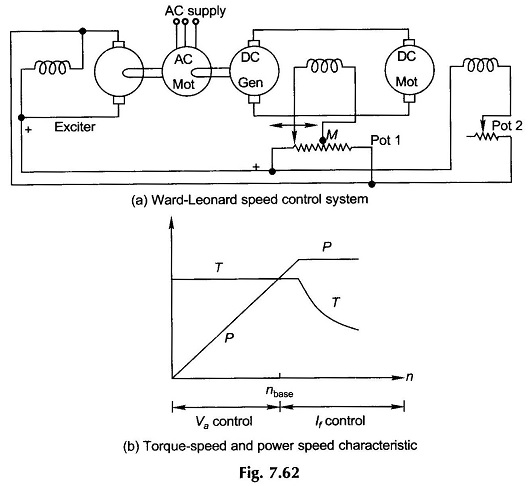Ward Leonard Method of Speed Control of DC Motor:
Ward Leonard Method of Speed Control of DC Motor is combined armature and field control and is therefore, operationally the most efficient method of speed control with a wide range. The dc motor armature is fed from a variable voltage and adjustable polarity supply whose current rating must be somewhat higher than that of the motor. The field (shunt) of the motor is separately excited from an independent dc source (low current rating).
Working Principle of Ward Leonard Method:
The variable voltage dc supply in older installations is obtained from a dc generator driven by a 3 phase squirrel cage motor. The field circuit of the generator is separately excited from a small rectifier unit or by an excitor coupled to an extension of the motor shaft. The complete arrangement of Ward Leonard Method of Speed Control of DC Motor is shown in Fig. 7.62(a).
The connection of the potentiometer (Pot 1) makes it possible to easily reverse the generator excitation thereby reversing the voltage polarity for reversal of the direction of rotation of the motor. This type of speed control is known as Ward Leonard Method of Speed Control of DC Motor. Modern installations use SCR circuitry for variable-voltage dc supply drawing power from ac mains through a transformer. Though expensive, this arrangement is neat and relatively free from maintenance problems. It is also easily adopted to feedback schemes for automatic control of speed.
At the base speed nb the motor armature is fed at rated voltage and its field current is adjusted to the maximum value, i.e. the field is excited at rated voltage. Reducing the armature voltage provides a constant-torque speed control where the speed can be reduced below the base value, while the motor has full torque capability (as If = max and Ia can have rated value). For obtaining speeds above nb, the field is gradually weakened. The motor torque therefore reduces as its speed increases which corresponds to constant-kW (or hp) drive. The kind of control over torque-speed characteristic achieved is illustrated in Fig. 7.62(b) where the nature of power-speed characteristic is also revealed.
Features and Advantages of Ward Leonard Method of Speed Control:
- The absence of an external resistance considerably improves the efficiency at all speeds. Another feature which enhances the efficiency is that when the generator emf becomes less than the back emf of the motor, electrical power flows back from motor to generator, is converted to mechanical form and is returned to the mains via the driving ac motor. The latter aspect makes it an ideal choice if frequent starting, stopping and reversals are required.
- No special starting gear is required. As the generator induced voltage is gradually raised from zero, the motor starts up smoothly.
- Speed reversal is smoothly carried out.
